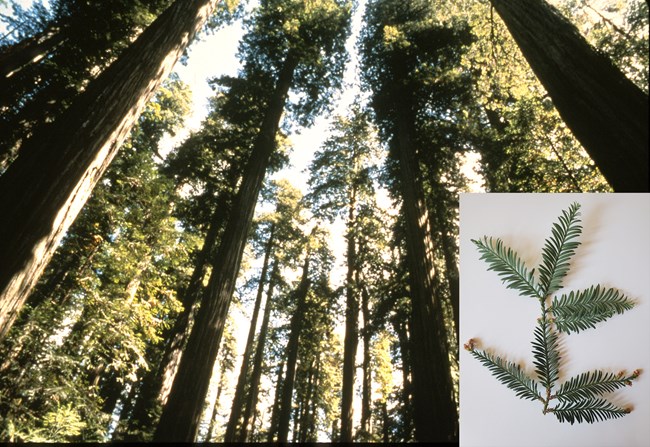Last updated: May 15, 2025
Article
Coast Redwood

NPS, inset courtesy C. Schelz
General Description
In Latin, semper means always, and virens means green, or flourishing. Two-thousand years ago, some of the oldest living coast redwoods (Sequoia sempervirens) were seedlings. This incredible longevity is matched only by the redwood’s equally astounding height. Its straight, reddish-brown trunk reaches over 350 feet, making it the tallest tree in the world. At ground level, a mature tree can exceed 20 feet in diameter.
Redwoods are closely related to the giant sequoia (Sequoiadendron giganteum) that grows at higher elevations in California’s Sierra Nevada. Both are members of the cypress family (Cupressaceae). While the giant sequoia is not as tall, it is even longer-lived (over 3000 years) and more massive than the redwood, some trees boasting a 40-foot-diameter girth.
Habitat
Redwood forests grow natively in a narrow band along the Pacific Coast, from central California to southern Oregon. They depend on a maritime climate, which provides the relatively stable temperature, moisture, and fog that redwoods need.
Ecology
Redwoods have a few tricks for surviving millennia. Mature trees are naturally resistant to fire thanks to their 12-inch-thick bark and lack of flammable pitch or resin. Bitter, chemical compounds in the wood, called tannins, keep both insects and diseases at bay. Windthrow is actually the main cause of natural mortality in mature trees. Remarkably, these tall trees have no taproots. Their roots grow only 10 to 13 feet vertically, and then spread horizontally for 60 to 80 feet, intertwining with the roots of other redwoods in a grove for stability.
Old-growth redwood forest is home to many species. Redwoods, Douglas-fir, western hemlock, tanoak, and madrone trees intermix above a rich understory of ferns and shrubs, including colorful rhododendrons. Spotted owls and marbled murrelets, both federally threatened birds, nest in the shady, moist canopy. Soil created from the decomposition of organic matter caught in branches sports gardens of fernmats, shrubs, and even small trees—hundreds of feet above the ground. Tree voles, bats, and salamanders are a few of the many animals other than birds living in the redwood forest canopy.
At such towering heights, you might wonder how redwoods deliver water from their roots to the top branches. By an astonishing feat of physics, water evaporating from the tiny pores in leaves (stomata) creates enough suction through the tree’s water pipelines (xylem) to make the lift. But there is more to the story. Redwoods also absorb water from fog at all levels of the canopy through their stomata. In the dry summer, fog accounts for nearly 40% of their water uptake. This “stripping” of fog onto redwood leaves also benefits the entire redwood ecosystem, as excess water drops onto the forest floor.
Reproduction
Redwoods are monoecious (monos = single, oikos = house), meaning that male and female parts grow on the same tree. Inconspicuous, yellowish male cones (~0.2 in) release pollen in late winter and early spring. The 1-inch-long woody female cones drop seeds in the late fall, but most do not germinate. Redwoods reproduce primarily asexually. The twisted and lumpy burls that typically grow at the base of the tree can sprout new growth if the tree is damaged. This new growth nourishes the tree’s vast root system and can eventually develop its own root system. If you’ve ever stepped inside a perfect circle of redwood trees, sometimes called a fairy ring, you are experiencing the new generation of sprouts from the base of an old, fallen redwood or its stump.
Conservation
Old-growth redwood forest historically covered 2 million acres in California. The beautiful wood and natural resistance to both fire and decay of this species, however, make it valuable timber. The California Gold Rush of 1848 brought extensive logging of redwoods to build San Francisco and surrounding cities. Just 4% of the original old-growth forest remains today, much of it in Redwood National and State Parks.
Where to See
In the Klamath Network, redwoods occur in Redwood National and State Parks.
More Information
https://www.nps.gov/redw/learn/nature/about-the-trees.htm
https://www.scientificamerican.com/article/follow-up-how-do-trees-ca/?print=true
https://www.savetheredwoods.org/redwoods/coast-redwoods/
Prepared by Sonya Daw
NPS Klamath Inventory & Monitoring Network
Southern Oregon University
1250 Siskiyou Blvd
Ashland, OR 97520
Featured Creature Edition: April 2017
